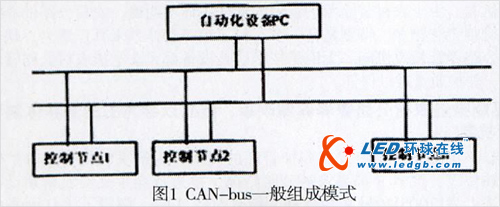Tunnel lighting is mainly to establish a tunnel environment with high efficiency, economy, comfort and safety, to ensure the driver's visual comfort during the day and night through the tunnel, so as to achieve safe driving. Traditional tunnel lighting uses high pressure sodium lamps as the illumination source. However, high-pressure sodium lamps have many shortcomings in radiation form, color rendering, visual sensitivity characteristics, power specifications, brightness control, etc., and the emerging LED tunnel lighting fixtures have overcome their excellent performance, especially the controllability of brightness. Many shortcomings of high-pressure sodium lamps, along with the deepening of scientific development concepts such as resource utilization and environmental protection, will surely become the mainstream lamps for tunnel lighting. Due to the controllability of the brightness of the LED, the intelligent control of the tunnel illumination has been realized.
1, CAN-bus features
CAN-bus (Controller Area Network) is the controller LAN. It was first proposed by Bosch in Germany. It is mainly used for data communication between the internal unit and the control center of the car. It has become one of the most widely used open field buses in the world. . It is a local area network that supports serial communication of distributed real-time control systems. Due to its high performance, high reliability, good real-time performance and unique design, it is widely used in detection and execution organizations in control systems of various fields. Data communication, such as automotive electronics, automatic machinery, intelligent buildings, power systems, security monitoring, ship shipping, elevator control, fire safety, etc.
1.1, CAN bus has the following - some outstanding advantages
1) Bus structure. A pair of transmission lines (buses) can be connected to multiple field devices to transmit multiple digital signals in two directions. This structure is simpler than one-to-one unidirectional analog signal transmission structure, low installation cost and easy maintenance.
2) Open interoperability. Fieldbus adopts a unified protocol standard and is an open Internet network that is transparent to users. In the traditional communication system, devices of different manufacturers cannot access each other, and CAN adopts a unified standard. Network products of different manufacturers can easily access the same network and integrate into the same control system for interoperability, thus simplifying the system. integrated.
3) Thorough decentralized control. The fieldbus decentralizes the control functions to the on-site smart meters and devices as network nodes, achieving thorough decentralized control, improving system flexibility, autonomy and safety and reliability, and reducing the computational burden of the DCS control station CPU.
4) High reliability. The use of digital signals to transmit data improves the accuracy and immunity of the data. The control function is placed in the field device to spread the danger and improve the reliability of the system.
5) Information integration and flexible configuration. By digitally transmitting field data, the CAN bus can acquire various status and diagnostic information of the field instruments, realizing real-time system monitoring and management.
CAN bus belongs to the field bus field. Its network topology adopts bus structure. The general composition mode is shown in Figure 1.
